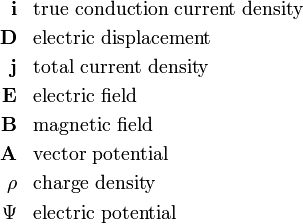James Clerk Maxwell/Addendum
We will present the equations given by Clerk Maxwell in modern vector form and precede them by his own comment in italics. The twenty variables recognized by Maxwell are the components of:
(A)
The relation between electric displacement, true conduction, and total current, compounded of both.
Here the total current density j is defined as the sum of the conduction current density i and displacement current (the time derivative of the electric displacement D).
(B)
The relation between the lines of magnetic force and the induction coefficients of a circuit, as already deduced from the laws of induction.
The magnetic field B is a divergence-free field and hence can be written as the curl of a vector potential A. Taking the divergence of both sides of the equation and using that the divergence of the curl of any vector field is zero (i.e.  ), gives the modern form in which this Maxwell equation is written: ∇ • B = 0, which states that B is divergence-free.
), gives the modern form in which this Maxwell equation is written: ∇ • B = 0, which states that B is divergence-free.
(C)
The relation between the strength of a current and its magnetic effects according to the electromagnetic system of measurement.
This is the Maxwell equation that is the extension of Ampère's equation by the displacement current. The equation takes different forms in different systems of units: sometimes the factor 4π is absent, sometimes there is division by c.
(D)
The value of the electromotive force in a body, as arising from the motion of the body in the field, the alteration of the field itself, and the variation of electric potential from one part of the field to another.
This equation gives in fact the Lorentz force on a particle of velocity v and unit charge. The last two terms represent the force due to the electric field, with Ψ the (scalar) electric potential. It seems that Maxwell only considered the case v = 0 in all his subsequent work. For v = 0 this equation can be converted by taking the curl on both sides, and using that the curl of a gradient is zero (i.e. ∇ × ∇ Ψ = 0). It thus becomes the Maxwell equation that is equivalent to Faraday's law.
(E)
The relation between electric displacement, and the electromotive force which produces it.
This is a constitutive relation between electric field and displacement; it holds for an isotropic and linear medium. k is a constant whose exact definition depends on the system of units used (as above).
(F)
The relation between an electric current, and the electromotive force which produces it.
This is basically Ohm's law, with r the specific resistivity.
(G)
The relation between the amount of free charge at any point, and the electric displacements in the neigbourhood.
Here ρ is the electric charge density and hence this is the Maxwell equation that is equivalent to Gauss' law.
(H)
The relation between the increase or diminution of free electricity and the electric currents in the neighbourhood.
This is the equation of conservation of electric charge (equation of continuity).










